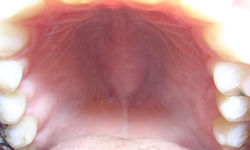அண்ணம்
Appearance
| அண்ணம் | |
|---|---|
 |
அண்ணம் (palate) என்பது வாயினுள் மேற்பகுதியில் கூரை போன்று மூடப்பட்டுள்ள பகுதியாகும். இது மூச்சுக்குகையையும் வாய்க்குகையையும் பிரிக்கிறது[1]. இதேபோன்று ஊர்வனவைகளின் நாற்காலிகளிலும் காணப்படுகிறது. ஆயினும் பெரும்பாலான நாற்காலிகளில் வாய்க்குகையும், மூச்சுக்குகையும் சரிவர பிரிக்கப்படவில்லை. அண்ணம் இரண்டு வகையாகப் பிரிக்கப்படுகிறது. முன்புறம், எலும்பையுடைய வன்னண்ணம் மற்றும் பின்புறத்தில் தசைகளையுடைய மென்னண்ணம் ஆகும்[2][3].[4][5]
மேற்கோள்கள்
[தொகு]- ↑ Wingerd, Bruce D. (1994). The Human Body Concepts of Anatomy and Physiology. Fort Worth: Saunders College Publishing. pp. 166. ISBN 0-03-055507-8.
{{cite book}}: Cite has empty unknown parameter:|coauthors=(help) - ↑ Wingerd, Bruce D. (1994). The Human Body Concepts of Anatomy and Physiology. Fort Worth: Saunders College Publishing. pp. 478. ISBN 0-03-055507-8.
{{cite book}}: Cite has empty unknown parameter:|coauthors=(help) - ↑ Goss, Charles Mayo (1966). Gray's Anatomy. Philadelphia: Lea & Febiger. p. 1172.
{{cite book}}: Cite has empty unknown parameter:|coauthors=(help) - ↑ Harper, Douglas. "palate (the entry for)". Online Etymology Dictionary. Retrieved 10 September 2011.
palate – late 14c., 'roof of the mouth,' from O.Fr. palat, from L. palatum 'roof of the mouth,' perhaps of Etruscan origin. Popularly considered the seat of taste, hence transferred meaning 'sense of taste' (1520s).
- ↑ Harper, Douglas. "palatine (the entry for)". Online Etymology Dictionary. Retrieved 10 September 2011.
palatine (adj.) – mid-15c., from M.Fr. palatin (15c.), from M.L. palatinus 'of the palace' (of the Caesars), from L. palatium (see palace). Used in English to mean 'quasi-royal authority.' Reference to the Rhineland state is from c.1580.
